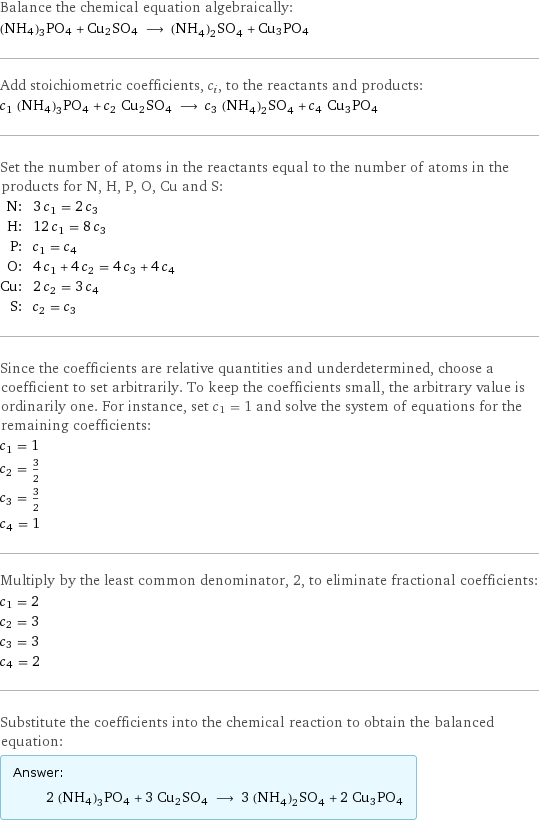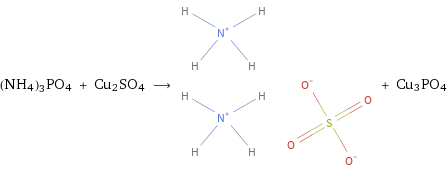Input interpretation

(NH4)3PO4 + Cu2SO4 ⟶ (NH_4)_2SO_4 ammonium sulfate + Cu3PO4
Balanced equation

Balance the chemical equation algebraically: (NH4)3PO4 + Cu2SO4 ⟶ (NH_4)_2SO_4 + Cu3PO4 Add stoichiometric coefficients, c_i, to the reactants and products: c_1 (NH4)3PO4 + c_2 Cu2SO4 ⟶ c_3 (NH_4)_2SO_4 + c_4 Cu3PO4 Set the number of atoms in the reactants equal to the number of atoms in the products for N, H, P, O, Cu and S: N: | 3 c_1 = 2 c_3 H: | 12 c_1 = 8 c_3 P: | c_1 = c_4 O: | 4 c_1 + 4 c_2 = 4 c_3 + 4 c_4 Cu: | 2 c_2 = 3 c_4 S: | c_2 = c_3 Since the coefficients are relative quantities and underdetermined, choose a coefficient to set arbitrarily. To keep the coefficients small, the arbitrary value is ordinarily one. For instance, set c_1 = 1 and solve the system of equations for the remaining coefficients: c_1 = 1 c_2 = 3/2 c_3 = 3/2 c_4 = 1 Multiply by the least common denominator, 2, to eliminate fractional coefficients: c_1 = 2 c_2 = 3 c_3 = 3 c_4 = 2 Substitute the coefficients into the chemical reaction to obtain the balanced equation: Answer: | | 2 (NH4)3PO4 + 3 Cu2SO4 ⟶ 3 (NH_4)_2SO_4 + 2 Cu3PO4
Structures

(NH4)3PO4 + Cu2SO4 ⟶ + Cu3PO4
Names

(NH4)3PO4 + Cu2SO4 ⟶ ammonium sulfate + Cu3PO4
Equilibrium constant
![Construct the equilibrium constant, K, expression for: (NH4)3PO4 + Cu2SO4 ⟶ (NH_4)_2SO_4 + Cu3PO4 Plan: • Balance the chemical equation. • Determine the stoichiometric numbers. • Assemble the activity expression for each chemical species. • Use the activity expressions to build the equilibrium constant expression. Write the balanced chemical equation: 2 (NH4)3PO4 + 3 Cu2SO4 ⟶ 3 (NH_4)_2SO_4 + 2 Cu3PO4 Assign stoichiometric numbers, ν_i, using the stoichiometric coefficients, c_i, from the balanced chemical equation in the following manner: ν_i = -c_i for reactants and ν_i = c_i for products: chemical species | c_i | ν_i (NH4)3PO4 | 2 | -2 Cu2SO4 | 3 | -3 (NH_4)_2SO_4 | 3 | 3 Cu3PO4 | 2 | 2 Assemble the activity expressions accounting for the state of matter and ν_i: chemical species | c_i | ν_i | activity expression (NH4)3PO4 | 2 | -2 | ([(NH4)3PO4])^(-2) Cu2SO4 | 3 | -3 | ([Cu2SO4])^(-3) (NH_4)_2SO_4 | 3 | 3 | ([(NH4)2SO4])^3 Cu3PO4 | 2 | 2 | ([Cu3PO4])^2 The equilibrium constant symbol in the concentration basis is: K_c Mulitply the activity expressions to arrive at the K_c expression: Answer: | | K_c = ([(NH4)3PO4])^(-2) ([Cu2SO4])^(-3) ([(NH4)2SO4])^3 ([Cu3PO4])^2 = (([(NH4)2SO4])^3 ([Cu3PO4])^2)/(([(NH4)3PO4])^2 ([Cu2SO4])^3)](../image_source/a772c7a9b3db6ee501060e8ca8aac279.png)
Construct the equilibrium constant, K, expression for: (NH4)3PO4 + Cu2SO4 ⟶ (NH_4)_2SO_4 + Cu3PO4 Plan: • Balance the chemical equation. • Determine the stoichiometric numbers. • Assemble the activity expression for each chemical species. • Use the activity expressions to build the equilibrium constant expression. Write the balanced chemical equation: 2 (NH4)3PO4 + 3 Cu2SO4 ⟶ 3 (NH_4)_2SO_4 + 2 Cu3PO4 Assign stoichiometric numbers, ν_i, using the stoichiometric coefficients, c_i, from the balanced chemical equation in the following manner: ν_i = -c_i for reactants and ν_i = c_i for products: chemical species | c_i | ν_i (NH4)3PO4 | 2 | -2 Cu2SO4 | 3 | -3 (NH_4)_2SO_4 | 3 | 3 Cu3PO4 | 2 | 2 Assemble the activity expressions accounting for the state of matter and ν_i: chemical species | c_i | ν_i | activity expression (NH4)3PO4 | 2 | -2 | ([(NH4)3PO4])^(-2) Cu2SO4 | 3 | -3 | ([Cu2SO4])^(-3) (NH_4)_2SO_4 | 3 | 3 | ([(NH4)2SO4])^3 Cu3PO4 | 2 | 2 | ([Cu3PO4])^2 The equilibrium constant symbol in the concentration basis is: K_c Mulitply the activity expressions to arrive at the K_c expression: Answer: | | K_c = ([(NH4)3PO4])^(-2) ([Cu2SO4])^(-3) ([(NH4)2SO4])^3 ([Cu3PO4])^2 = (([(NH4)2SO4])^3 ([Cu3PO4])^2)/(([(NH4)3PO4])^2 ([Cu2SO4])^3)
Rate of reaction
![Construct the rate of reaction expression for: (NH4)3PO4 + Cu2SO4 ⟶ (NH_4)_2SO_4 + Cu3PO4 Plan: • Balance the chemical equation. • Determine the stoichiometric numbers. • Assemble the rate term for each chemical species. • Write the rate of reaction expression. Write the balanced chemical equation: 2 (NH4)3PO4 + 3 Cu2SO4 ⟶ 3 (NH_4)_2SO_4 + 2 Cu3PO4 Assign stoichiometric numbers, ν_i, using the stoichiometric coefficients, c_i, from the balanced chemical equation in the following manner: ν_i = -c_i for reactants and ν_i = c_i for products: chemical species | c_i | ν_i (NH4)3PO4 | 2 | -2 Cu2SO4 | 3 | -3 (NH_4)_2SO_4 | 3 | 3 Cu3PO4 | 2 | 2 The rate term for each chemical species, B_i, is 1/ν_i(Δ[B_i])/(Δt) where [B_i] is the amount concentration and t is time: chemical species | c_i | ν_i | rate term (NH4)3PO4 | 2 | -2 | -1/2 (Δ[(NH4)3PO4])/(Δt) Cu2SO4 | 3 | -3 | -1/3 (Δ[Cu2SO4])/(Δt) (NH_4)_2SO_4 | 3 | 3 | 1/3 (Δ[(NH4)2SO4])/(Δt) Cu3PO4 | 2 | 2 | 1/2 (Δ[Cu3PO4])/(Δt) (for infinitesimal rate of change, replace Δ with d) Set the rate terms equal to each other to arrive at the rate expression: Answer: | | rate = -1/2 (Δ[(NH4)3PO4])/(Δt) = -1/3 (Δ[Cu2SO4])/(Δt) = 1/3 (Δ[(NH4)2SO4])/(Δt) = 1/2 (Δ[Cu3PO4])/(Δt) (assuming constant volume and no accumulation of intermediates or side products)](../image_source/3f0388ce0a6dcb12a43e2df10422f2c6.png)
Construct the rate of reaction expression for: (NH4)3PO4 + Cu2SO4 ⟶ (NH_4)_2SO_4 + Cu3PO4 Plan: • Balance the chemical equation. • Determine the stoichiometric numbers. • Assemble the rate term for each chemical species. • Write the rate of reaction expression. Write the balanced chemical equation: 2 (NH4)3PO4 + 3 Cu2SO4 ⟶ 3 (NH_4)_2SO_4 + 2 Cu3PO4 Assign stoichiometric numbers, ν_i, using the stoichiometric coefficients, c_i, from the balanced chemical equation in the following manner: ν_i = -c_i for reactants and ν_i = c_i for products: chemical species | c_i | ν_i (NH4)3PO4 | 2 | -2 Cu2SO4 | 3 | -3 (NH_4)_2SO_4 | 3 | 3 Cu3PO4 | 2 | 2 The rate term for each chemical species, B_i, is 1/ν_i(Δ[B_i])/(Δt) where [B_i] is the amount concentration and t is time: chemical species | c_i | ν_i | rate term (NH4)3PO4 | 2 | -2 | -1/2 (Δ[(NH4)3PO4])/(Δt) Cu2SO4 | 3 | -3 | -1/3 (Δ[Cu2SO4])/(Δt) (NH_4)_2SO_4 | 3 | 3 | 1/3 (Δ[(NH4)2SO4])/(Δt) Cu3PO4 | 2 | 2 | 1/2 (Δ[Cu3PO4])/(Δt) (for infinitesimal rate of change, replace Δ with d) Set the rate terms equal to each other to arrive at the rate expression: Answer: | | rate = -1/2 (Δ[(NH4)3PO4])/(Δt) = -1/3 (Δ[Cu2SO4])/(Δt) = 1/3 (Δ[(NH4)2SO4])/(Δt) = 1/2 (Δ[Cu3PO4])/(Δt) (assuming constant volume and no accumulation of intermediates or side products)
Chemical names and formulas

| (NH4)3PO4 | Cu2SO4 | ammonium sulfate | Cu3PO4 formula | (NH4)3PO4 | Cu2SO4 | (NH_4)_2SO_4 | Cu3PO4 Hill formula | H12N3O4P | Cu2O4S | H_8N_2O_4S | Cu3O4P name | | | ammonium sulfate |
Substance properties

| (NH4)3PO4 | Cu2SO4 | ammonium sulfate | Cu3PO4 molar mass | 149.09 g/mol | 223.15 g/mol | 132.1 g/mol | 285.61 g/mol phase | | | solid (at STP) | melting point | | | 280 °C | density | | | 1.77 g/cm^3 | odor | | | odorless |
Units
